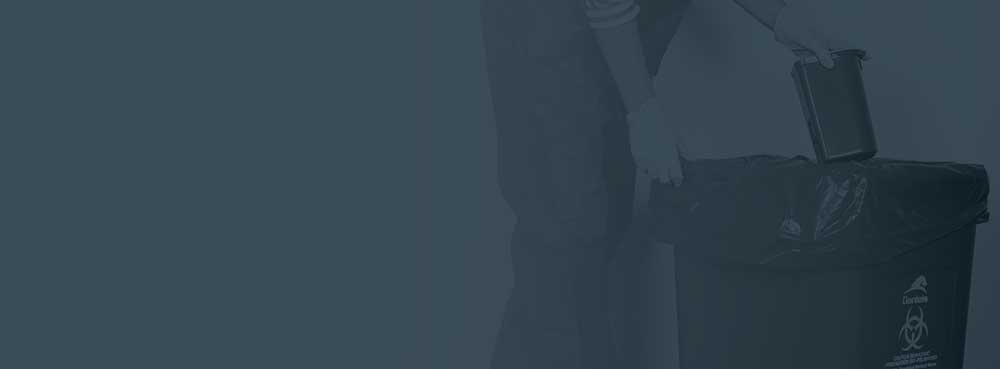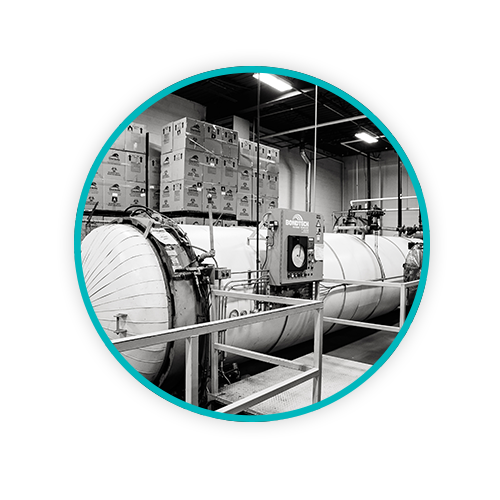Insight into the Disposal Methods for Biohazardous Waste

Are you familiar with the classic sleight-of-hand trick of having three upside-down cups, placing a ball under one of the cups, and then mixing them around until the participant has to hopefully guess the right cup containing the ball?…
That is how challenging it can be to understand what category of disposal certain medical waste streams fall under. However, Daniels Health is always here to assist in your education and learn with you. Let’s dive into disposal methods for biohazardous waste—often referred to as “red bag” waste. “Red bag” waste is a bit more complex than one bag and color. One red bag may contain sheets from isolation while another may contain feet from a research lab—that’s why proper disposal and classification is so important.
In each blog we stress how important it is for waste generators to not only know the difference between different types and categories of medical waste but also the proper disposal for each. Federal and state regulations for medical waste disposal are extensive and depend on the type of waste. Hazardous waste disposal is typically perceived as biohazardous waste—this is not always the case. Hazardous waste can be a lot of things from lightbulbs to pharmaceuticals to barrels of questionable goo from factories. Medical waste disposal guidelines are provided by the US Environmental Protection Agency (EPA) although state regulations also apply. State regulations differ. Knowing your region’s rules and following them reduces the risk of noncompliance and resulting fines and penalties. View state regulations for medical waste here.
What is considered biohazardous waste?
Biohazard waste is defined as any healthcare waste potentially contaminated by infectious materials, blood, or bodily fluids. Disposal of biohazard waste falls under regulated medical waste (RMW) guidelines. Different categories of medical waste are known as waste “streams.” Different waste streams must follow regulated medical waste guidelines and may differ in their disposal methods. The RMW “streams” include:
- Sharps (in a sealed disposable sharps container, or more preferably in a reusable Daniels Sharspsmart container)
- Microbiological waste
- Pathological (anatomical) waste
- Infectious waste
In short, biohazardous is anything that has the potential to contaminate, infect, disperse or otherwise pose a danger from the object in question to a patient, healthcare worker, a waste management employee, or the general public. In addition to federal guidelines, there are governmental agencies such as the EPA and RCRA legislation, The Occupational Safety and Health Administration (OSHA), and specific states around the country that have their own jurisdictions regarding medical waste disposal. It’s important to know what specific regulations apply to your region.
State-specific guidelines for biohazard waste disposal
You cannot adhere to state guidelines and throw federal regulations to the wind—you have to follow both. It’s kind of like how you can’t mail a letter without a stamp, even if you have the address on it. Terminology and specifications of biohazardous waste disposal differs slightly from state to state. For example, Colorado’s hazardous waste regulations are found in the Department of Public Health and Environment Regulation 6 CCR 1007-3. This regulation defines terminology and regulations for general hazardous waste management, identification of hazardous waste, and applicable standards for medical waste generators and transporters of biohazard waste.
Ohio’s Division of Materials and Waste Management is found under Ohio’s Environmental Protection Agency Regulations (Chapter 3734) of the Ohio revised code. The code defines regulation of generation and treatment of infectious waste and approved treatment methods.
Florida’s Department of Health and the Department of Environmental Protection stipulates guidelines for the proper management of biomedical waste disposal. These guidelines are found under §381.0098 of Florida statutes and under Chapter 64E-16 of Florida’s Administration Code. The state also offers information via a biomedical waste operating plan for facilities that define its purpose, training, and proper segregation of biomedical waste, containment procedures, labelling, storage, and procedures.
Each state is a little unique in their disposal methods, in case the point of the above stats were missed. It’s okay—I skim too.
Common disposal methods for biohazardous waste
A number of suitable methods for biohazard waste disposal include:
- Incineration – It’s getting hot in here. Incineration is a cost-effective disposal method for biohazardous waste. Incineration defines the burning of medical waste produced by healthcare facilities such as medical research facilities, veterinary care, and physician’s offices and hospitals. Such wastes often include red bag materials and noninfectious materials. Several types of incineration methods are used in the US, the primary being controlled air incinerators. Such incinerators have a capacity of 75 to 6,500 pounds an hour, producing heat rates of approximately 15,000 to 25,000 Btu/hr-ft3.
 Autoclaving – Like a really, really aggressive steam room at the gym. This method is effective in sterilizing and treating medical waste prior to disposal, achieved through steam heat exceeding a temperature of 300°. Autoclaves range in size from several square feet to those over 20 feet long and 10 feet high. Autoclaving is a common method in treating regulated medical waste or biohazardous waste, and is effective in killing bacteria in infectious materials. (Autoclave pictured)
Autoclaving – Like a really, really aggressive steam room at the gym. This method is effective in sterilizing and treating medical waste prior to disposal, achieved through steam heat exceeding a temperature of 300°. Autoclaves range in size from several square feet to those over 20 feet long and 10 feet high. Autoclaving is a common method in treating regulated medical waste or biohazardous waste, and is effective in killing bacteria in infectious materials. (Autoclave pictured)- Chemical disinfection – In some cases, and based on federal and state guidelines, some biohazard waste streams can be chemically disinfected.
- Encapsulation – Sharps require special handling when it comes to disposal methods. A sharps container is one of the most common, but containers must meet federal and state guidelines in regard to durability, safety, and containment. Needle sticks caused by sharps (needles, surgical blades or other instruments) continue to be one of the most prevalent dangers for healthcare workers today. According to the Centers for Disease Control and Prevention (CDC), roughly 385,000 sharps related injuries and needle sticks occur on an annual basis in hospitals. While encapsulation is required, why not save yourself even further injury risk and money by speaking to a Daniels Health consultant about our reusable Sharpsmart. Our system is proven to reduce sharps risk of sharps injuries by over 80%.
Not all medical waste disposal methods are suitable for pharmaceutical, chemotherapy or hazardous waste disposal. Safety to healthcare professionals and the public at large is essential and it’s essential that you receive educated advice when it comes to the handling of each healthcare generated waste stream.
Safety, safety, safety… did I mention safety?
In-depth understanding of common disposal methods for biohazardous waste based on federal and state guidelines is essential to safety and preventing injury to patients, healthcare workers, and transportation workers. Reducing sharps injuries, reducing exposure to blood-borne pathogens, and reducing the risk of hospital-acquired infections (HAIs) is the goal of all state jurisdictions when it comes to the handling, segregation, and disposal of biohazardous waste.
Daniels Health is dedicated to increasing safety and compliance through education and provides sustainable options when it comes to segregation and such methods reduce repeated handling of biohazard waste and also reduces the volume of waste heading to local landfills.
Let's Talk!
Your time is valuable, and we don’t want to play hard to get. You can either phone us directly on the details listed on our contact page, or feel free to fill out this short form and one of our team members will get back to you as quickly as possible.
